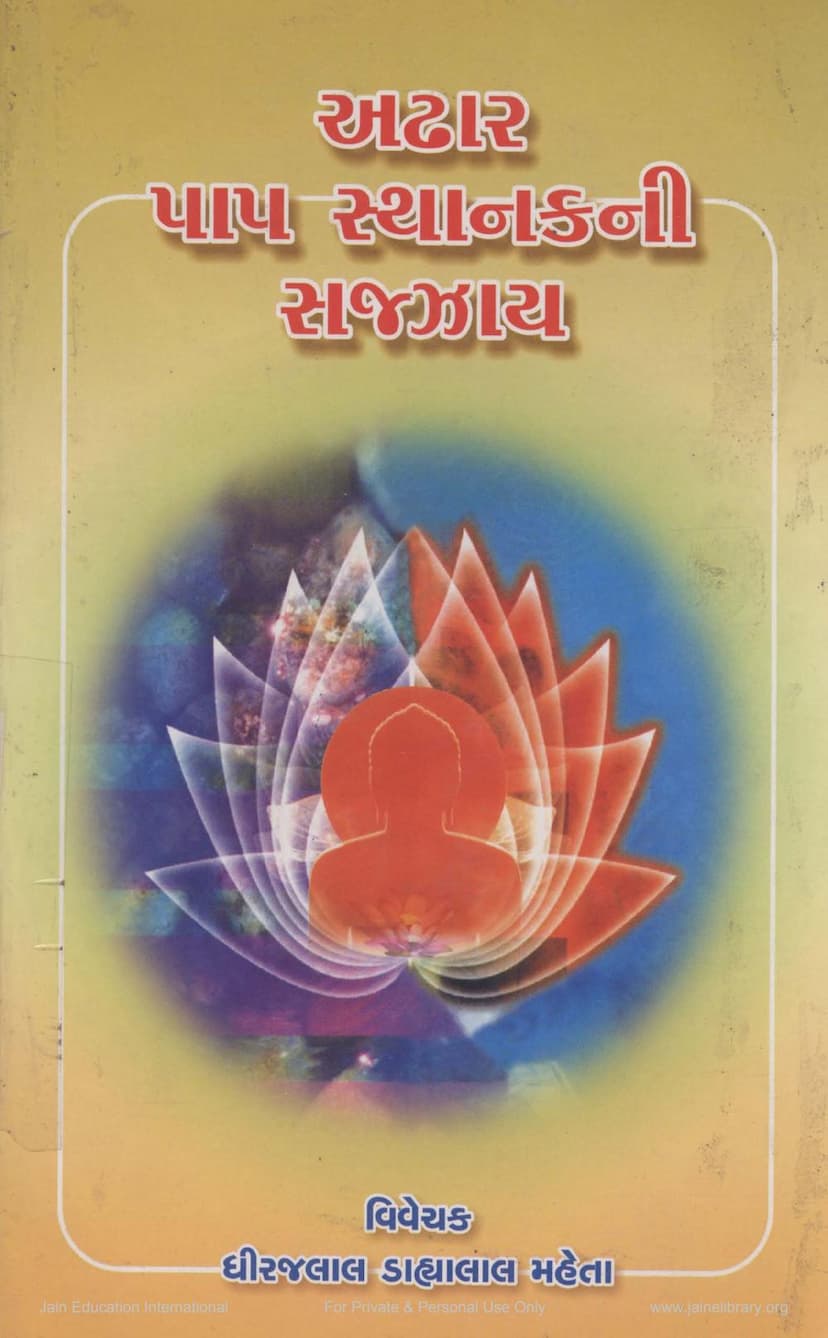Adhar Pap Sthanakni Sazzaya
Added to library: September 1, 2025

Summary
Here's a comprehensive summary of the Jain text "Adhar Pap Sthanakni Sazzaya," based on the provided pages:
Book Title: Adhar Pap Sthanakni Sazzaya (Sixteen Pap Sthanakni Sazzaya) Author: Upadhyay Yashovijayji Maharaj Commentator: Dhirajlal Dahyalal Mehta Publisher: Shri Jain Dharm Prasaran Trust, Surat Catalog Link: https://jainqq.org/explore/005112/1
Overview:
"Adhar Pap Sthanakni Sazzaya" is a significant Jain text that explores the eighteen types of "Pap Sthanak" (locations or actions that lead to sin and karmic bondage) through a series of devotional songs called "Sazzaya." The book features a commentary in Gujarati by Dhirajlal Dahyalal Mehta, aiming to elucidate the original work by the revered Upadhyay Yashovijayji Maharaj.
Core Message and Purpose:
The fundamental purpose of this text is to educate Jains, particularly laypeople, about the eighteen fundamental categories of sinful actions (Pap Sthanak) that perpetuate the cycle of birth and death and lead to suffering. By understanding these "Pap Sthanak" clearly, individuals can strive to renounce them from their lives, leading to spiritual progress and eventual liberation. The text emphasizes that recognizing and knowing these negative actions is the first step towards abandoning them.
The 18 Pap Sthanak (Sinful Actions):
The commentary systematically outlines and explains each of the 18 Pap Sthanak, which are also recited daily in Jain prayer and repentance rituals ("Pratikraman"). These are presented as actions that must be abandoned for spiritual well-being. The identified Pap Sthanak are:
- Pranaatipata (Violence/Harming Life): Including the destruction of life, causing mental pain, hurting sentiments, physical violence, and quarrels.
- Mrushavada (Falsehood/Lying): Speaking untruths, hiding facts by lying, and deceptive speech.
- Adattadana (Stealing): Taking anything that belongs to another without permission, even the intention to take.
- Maithuna (Sensual Indulgence): Engaging in sexual activity, or actions related to worldly pleasures.
- Parigraha (Possessiveness/Attachment): Mental attachment and possessiveness, as well as the accumulation of wealth and material possessions (karmic accumulation).
- Krodha (Anger): Intense emotion, fury, and getting agitated.
- Mana (Pride/Ego): Arrogance, self-importance, and conceit.
- Maya (Deceit/Illusion): Craftiness, trickery, having different intentions internally than what is expressed externally, and pretense.
- Lobha (Greed/Attachment): Craving, longing, possessiveness, and a sense of "mine."
- Raga (Attachment/Affection): Love, fondness, and emotional connection.
- Dvesha (Aversion/Hatred): Resentment, envy, dislike, and unhappiness.
- Kalaha (Conflict/Quarrel): Disputes, bitterness, and arguments.
- Abhyakhyana (False Accusation): Wrongfully blaming or accusing someone, spreading false rumors.
- Paishunya (Slander/Gossip): Backbiting and spreading rumors.
- Rati-Arati (Likes and Dislikes): Inner affection and aversion, pleasure and displeasure, happiness and unhappiness.
- Paraparivada (Criticizing Others): Denigrating others, finding fault, portraying others as blameworthy, and speaking ill of anyone.
- Mayamrushavada (Deceitful Lying): Lying with deceitful intentions.
- Mithyatva Shalya (False Belief/Wrong View): Perverted intellect, wrong perspective, considering false principles as true and true principles as false.
Commentary and Explanatory Approach:
Dhirajlal Mehta's commentary aims to make the profound teachings of Yashovijayji Maharaj accessible in simple Gujarati. It breaks down the meaning of the Sazzaya, providing detailed explanations and often citing illustrative stories and examples from Jain scriptures to clarify the abstract concepts. The commentary encourages contemplation and regular study to overcome these sinful tendencies. The commentator also acknowledges the assistance and inspiration received from various esteemed Jain monks and scholars.
Key Themes and Emphasis:
- Causality of Suffering: The text clearly links the act of committing Pap Sthanak to the accumulation of karma, which in turn leads to suffering, repeated births, and deaths.
- Importance of Knowledge: True liberation comes from recognizing and understanding these pitfalls. Mere intellectual knowledge is insufficient; it must lead to renunciation and practice.
- Practical Application: The explanations are designed to be practical, guiding individuals on how to identify and avoid these negative actions in their daily lives.
- Spiritual Growth: The ultimate goal is the purification of the soul and the attainment of ultimate happiness and liberation (Moksha).
- Renunciation: The core teaching is the need to abandon these eighteen Pap Sthanak for the well-being of the soul.
Structure of the Sazzaya:
The book is structured such that each of the 18 Pap Sthanak has its corresponding Sazzaya, followed by a detailed explanation. The "Anukramanika" (Table of Contents) clearly lists each Pap Sthanak and the page numbers, facilitating easy reference.
Contribution and Legacy:
The publication of this commentary by Shri Jain Dharm Prasaran Trust, Surat, makes the valuable teachings of Upadhyay Yashovijayji Maharaj available to a wider audience, contributing significantly to Jain education and spiritual awareness. The book is presented as a tool for self-improvement and spiritual welfare.